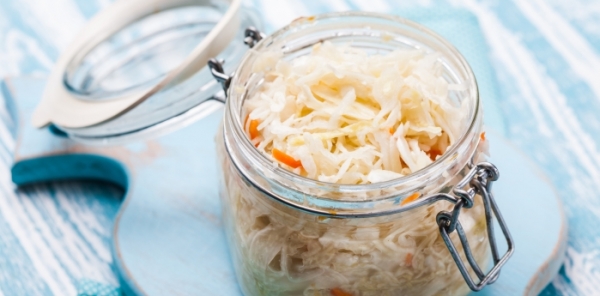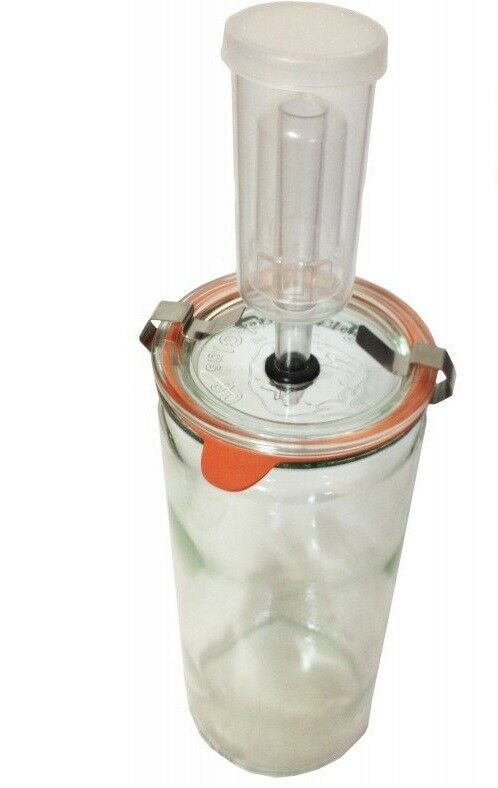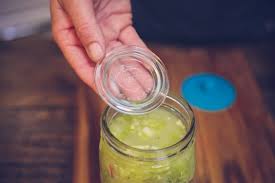Sauerkraut
Sauerkraut is a condiment suggested to be eaten as a side dish whenever meat is consumed and especially at the end of the day when the body’s enzyme storage is depleted having already been expended on previous meals earlier in the day. The evening meal is often the most difficult for people who suffer from […]

| Servings |
Litre
|
Ingredients
Sauerkraut
- 1 Organic Green Cabage Select fresh organic only to enable enough juice extraction
- 15 - 30 grams Celtic or Himalayan Sea Salt 15 grams (max 15 grams) per 1 kg cabbage
- 1-2 satchals Vegetable Culture Starter Optional depending on whether you are using a wild or culture fermentation method
- 1 Tsp Dill Optional
Sauerkraut Equipment
- 1 Fermentation Vessel A glass jar or crock with a weight to hold the vegetables submerged under the brine and an airlock system with a release valve to allow air to escape whilst creating an anaerobic environment. Refer to Weck images below
- 1 Mandolin For slicing cabage (or use a knife)
Ingredients
Sauerkraut
Sauerkraut Equipment
|

|
Instructions
- Thinly slice or shred the cabbage with a knife or mandolin. I like to use a mandolin.
- Place the shredded cabbage in a large glass bowl and add the dill (optional).
- For Wild Fermentation, add a generous amount of salt to the cabbage and mix it through with your hands to allow an overall coverage. Let it sit for 15 – 20 minutes to allow the salt to draw out some of the cabbage juice naturally. 5-8grams - (max 15grams) per 1kg cabbage. HINTS: Salt allows the cabbage to sweat so that juices can be extracted to create the brine. For Cultured fermentation, add the commercial culture starter as per packet instructions.

- Mix, massage and knead the ingredients with your hands. Bruising the cabbage this way allows the cabbage to extract a natural brine solution. Keep kneading until you have squeezed a substantial amount of juice from the mixture. Sometimes this may take 10-20 minutes. HINTS: It is beneficial to have someone with strong hands to do the kneading & massaging.
- Place mixture into the selected fermenting vessel and pack and push the mixture down so that the cabbage is compacted in the bottom and the juice is sitting on the top of the cabbage with a minimum of 4 - 5cm’s or 2 inches. It is important to push the cabbage down firmly so that no air is trapped and the cabbage is completely submerged in and under its own brine juice. HINTS: If for any reason the cabbage is not submerged under enough of its own juices, you may need to add a small amount of filtered water with more salt (15 gms of salt to 1 ltr).
- Place the weight on the top of the cabbage to keep all the cabbage submerged. Push the weight down and you will see more juice rise to the top. It is very important to ensure that all the sauerkraut is submerged under its own juice. If any bits of cabbage float up to the surface, remove them throughout the fermentation process to prevent them from going moldy.

- If you use a canning jar with a rubber ring top, and close the lid, be sure to burp it a few times in the first few days to release the pressure. If using the weck airlock system which has it's own release valve allowing gasses to escape without letting air into the jar, place the rubber ring around the top and clamp down the lid with the attached release valve to the top. Store in a dark place for one to two weeks (ie pantry).
- The sauerkraut may be consumed and ready to eat after 5-7 days but it matures better with age so it is good to wait the full two weeks unless the outside temperature is hot which will speed up the fermentation process.
- The sauerkraut may be stored in the fridge after 1-2 weeks of fermentation. If there is any scum or mold development on the top – remove this. The kraut remaining under the juice will be fine.
Recipe Notes
Optional: It is also nice to add a little grated carrot to your sauerkraut.
